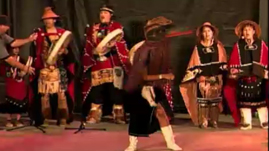Teachers' Domain - Digital Media for the Classroom and Professional Development
User: Preview



The Git-Hoan Dancers perform the Raven Dance, a celebration of the Raven Clan. They wear masks representing the clan. In Tsimshian culture, the wearer of a mask is said to take on the spirit of the creature it signifies.
This resource is part of the Native American Culture collection.
Find additional arts resources for your classroom at the KET Arts Toolkit website.
The Git-Hoan Dancers are descended from the Tsimshian people of the Northwest Coast of northern British Columbia and southeastern Alaska. Tsimshian translates to “inside the Skeena River.” In 1862, smallpox annihilated 80% of the Tsimshian population over three years’ time. Further epidemics ravaged their communities for many years. And as with other Native American peoples, Tsimshian dance and culture were suppressed by missionary and government control. Given all these factors, it is astonishing that Tsimshian dance has not only survived but is currently undergoing a revival.
As Native peoples have gained more control over their own lives and their reservations, the culture of traditional dance, both ceremonial and social, has emerged stronger than ever. In some instances, tribes have had to reconstruct ceremonies and dances based on the memories of a few elders. Some tribes that had lost their languages and dances completely have been gifted with dances from other tribes. Ceremonial dances are not just “made up” in Native cultures. They are gifts from spirit beings granted through dreams or visions and belong to the clan or tribe of the dreamer or visionary. They can be traded or given away as gifts of great power, but they should never be stolen or imitated without permission through gifting. In modern days, with the emergence of a pan-Indian cultural identity, the tradition of gifting has enabled some tribes to rebuild a sense of native identity.
The Git-Hoan Dancers are allowed to use the Raven song because David Boxley, leader and culture bearer of the Git-Hoan Dancers, traded a song that he wrote to a woman from British Columbia who had written the Raven Song. The Raven Dance is performed in honor of the Raven Clan. In Tsimshian culture, there are two main divisions, the Raven and Eagle clans. The Eagle Dance is performed to honor the Eagle clan. Like the Raven Dance, it involves the use of a large mask with moveable parts and movements that reflect the spirit of the eagle.
Raven is a central character in Northwest Coast stories. He is believed to be the creator of the physical world and the bringer of light. Raven has supernatural powers, and is also a “trickster” who gets what he wants by playing mischievous tricks on others, changing his shape at will. When the dancers put on raven masks, they become the ravens, and all their movements mimic the way ravens would move. The masks have moveable beaks so that the dancers can clack them. This dance takes great stamina and strength in order to manipulate the mask and dance in a crouched position.
 Loading Standards
Loading Standards